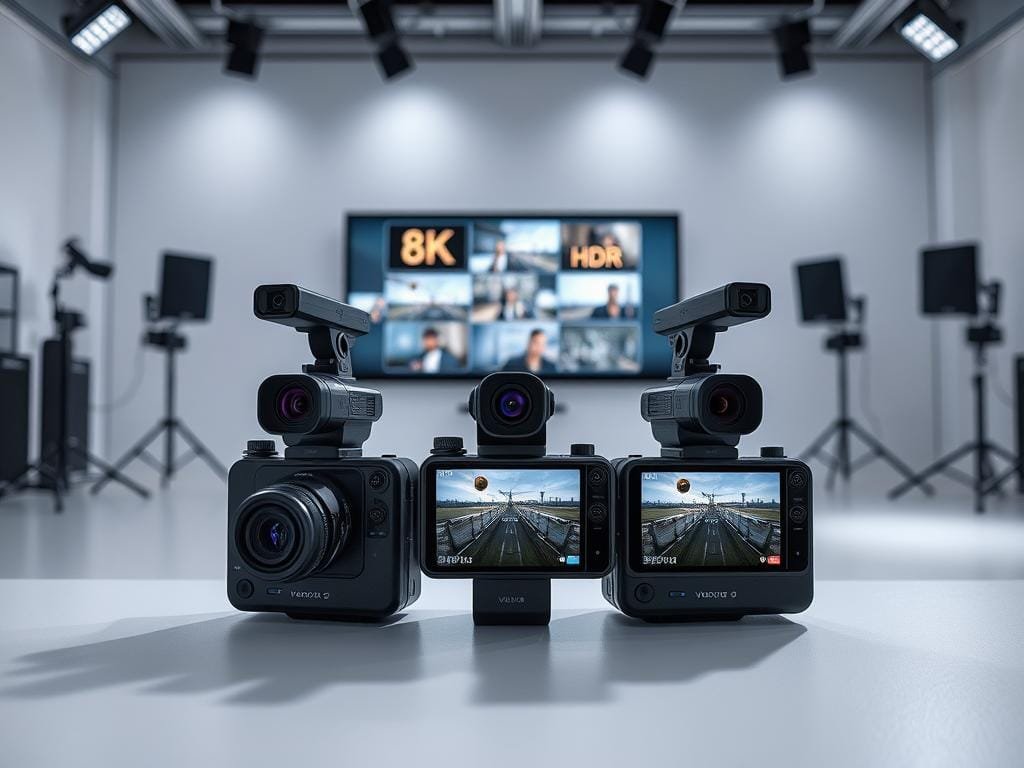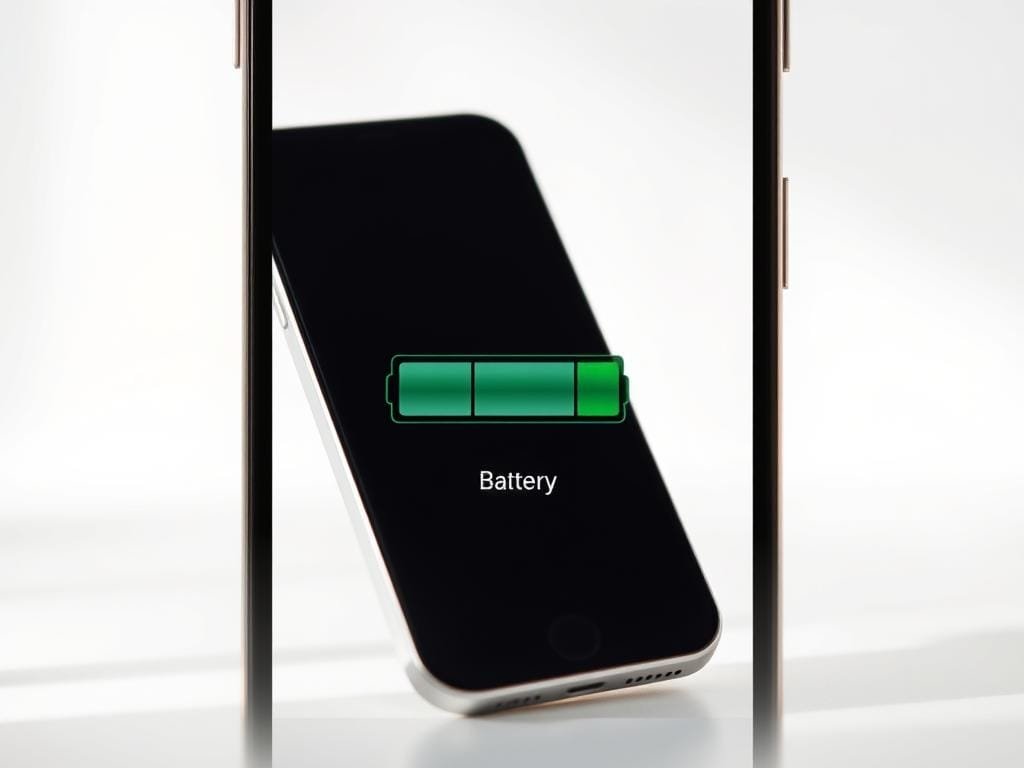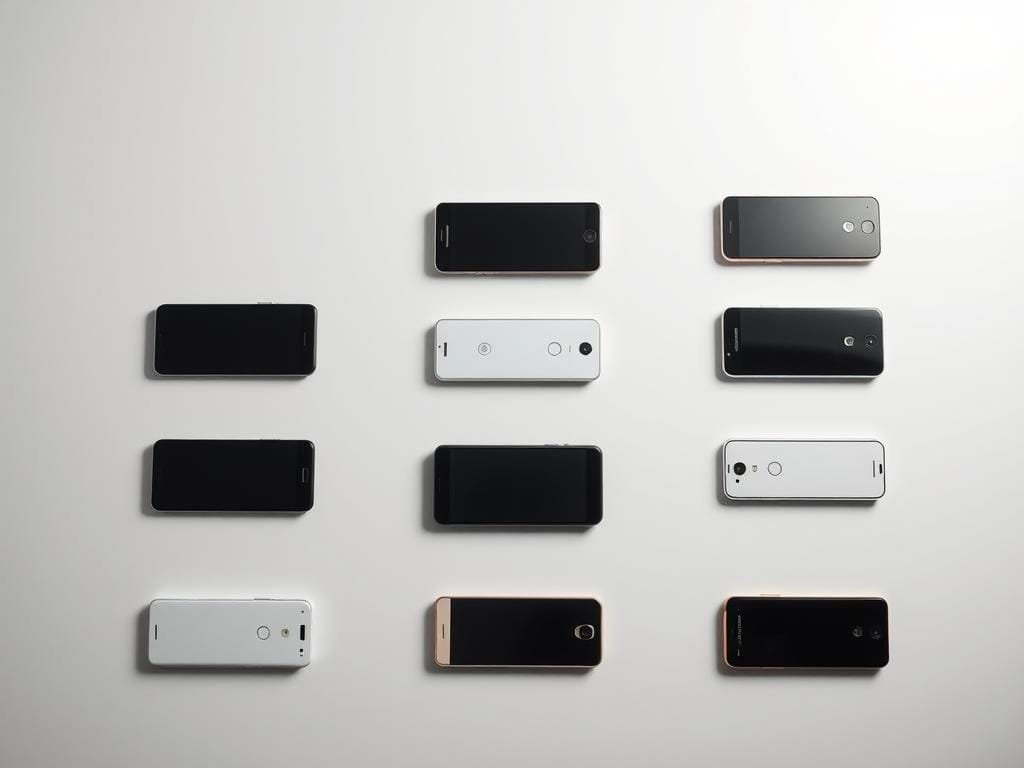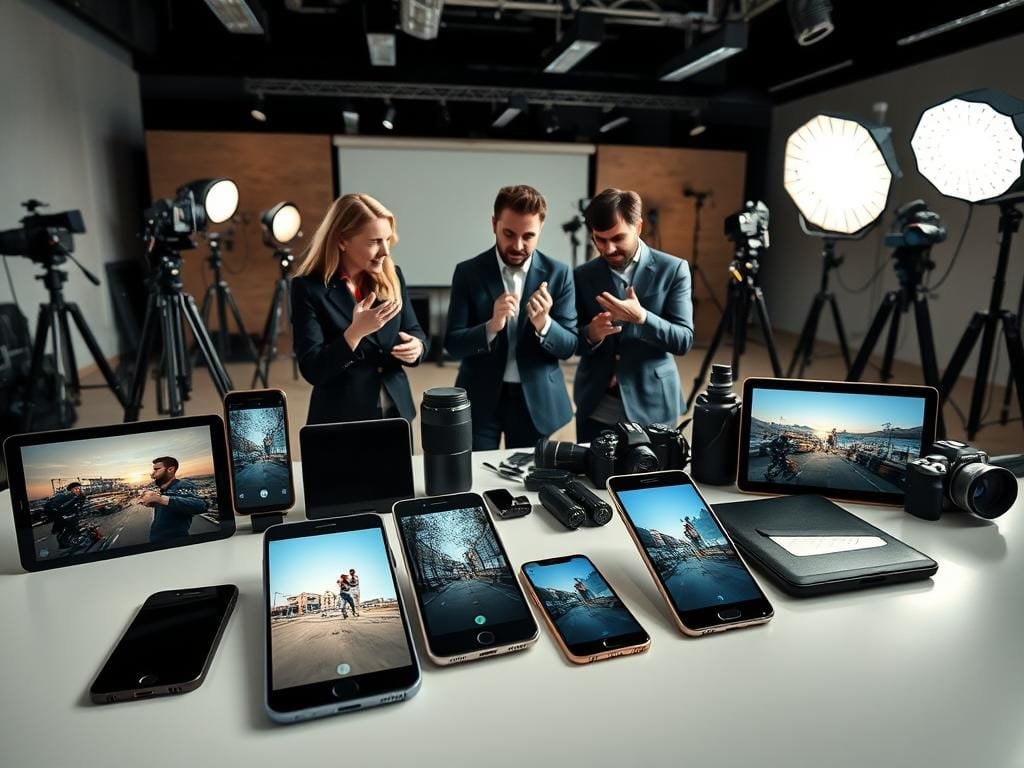Smartphone cameras have changed how we capture life’s moments. Over 1.4 billion smartphones are sold every year. Camera quality is now a key focus for makers.
The newest phones from Apple, Samsung, and Google have advanced camera tech. They offer better low-light shots and video. When you’re thinking of getting a new phone, it’s hard to choose. We’ll compare the latest iPhone, Galaxy, and Pixel to find the best camera phone.
Key Takeaways
- Comparison of the latest smartphone cameras from Apple, Samsung, and Google
- Analysis of key camera features, including low-light performance and video recording
- Insights into the best phone features for photography enthusiasts
- Evaluation of the overall camera performance of each device
- Guidance on choosing the best smartphone for your camera needs
Overview of Smartphone Camera Technology in 2025
The latest smartphones in 2025 have cameras that rival professional gear. This big step forward comes from better sensors, advanced software, and computational photography.
Recent Innovations in Smartphone Cameras
Smartphone cameras have gotten a lot better. A big change is the use of multi-lens systems. These systems let you take wide-angle, telephoto, and macro shots.
Another key improvement is in image processing algorithms. These algorithms make photos clearer by reducing noise and improving colors. Now, your smartphone can take photos that look like they were taken by a pro.
The Rise of Computational Photography
Computational photography has changed how smartphones take pictures. With powerful processors and smart software, smartphones can now take photos that beat traditional cameras. Features like multi-frame noise reduction and advanced HDR make images much better.
Computational photography is not just about the hardware; it’s about how the software uses that hardware to create something new and exciting.” –
Trends Shaping the Future
Looking ahead, several trends will shape smartphone camera tech. One big trend is using AI and machine learning to improve cameras. This includes better scene detection, object tracking, and personalized settings.
| Trend | Description | Impact |
|---|---|---|
| AI Integration | Enhanced camera capabilities through AI | Improved scene detection and object tracking |
| Multi-Lens Systems | Versatility in photography with different lenses | Greater flexibility for users |
| Advanced Image Processing | Improved algorithms for better image quality | Professional-looking photos directly from smartphones |
These trends show that smartphone cameras will keep getting better. They will offer more features and better photos in the future.
Camera Specs Comparison: iPhone, Galaxy, and Pixel
When it comes to smartphone photography, knowing the camera specs is key. The latest phones from Apple, Samsung, and Google have different specs. These differences can greatly affect how good your photos look.
Megapixels: Do They Matter Anymore?
The debate on megapixels has been going on for a while. Some think more megapixels mean better photos. But it’s not that simple. A higher megapixel count can make images more detailed, but it’s not everything.
The iPhone 15 Pro Max has a 48-megapixel main camera. The Galaxy S24 Ultra has a 108-megapixel primary sensor. The Pixel 7 Pro has a 50-megapixel main camera. Let’s see how these differences affect real-world photos.
Lens Quality and Aperture Differences
Lens quality and aperture are very important for camera performance. A wider aperture lets in more light, which is great for low-light photos. The Galaxy S24 Ultra has a variable aperture, changing between f/1.8 and f/4.0.
The iPhone 15 Pro Max has a fixed aperture of f/1.8. The Pixel 7 Pro has an aperture of f/1.85. These differences can really affect your photos, making them better or worse in different lighting.
Optical vs. Digital Zoom Capabilities
Zoom is another key feature of smartphone cameras. Optical zoom uses the lens to zoom in without losing quality. Digital zoom uses software, which can make images blurry.
The Galaxy S24 Ultra has a 100x digital zoom. But its optical zoom is not as strong. For a detailed comparison, check out this CNET article comparing the iPhone 15 Pro Max and the Galaxy S24 Ultra.
| Smartphone | Main Camera Megapixels | Aperture | Optical Zoom |
|---|---|---|---|
| iPhone 15 Pro Max | 48MP | f/1.8 | 3x |
| Galaxy S24 Ultra | 108MP | f/1.8 – f/4.0 | 3x |
| Pixel 7 Pro | 50MP | f/1.85 | 2x |
Image Quality: Real-World Tests and Reviews
Image quality is key when picking the best smartphone camera. Our tests show how the iPhone, Galaxy, and Pixel compare. We look at color accuracy, low-light performance, and dynamic range.
Color Accuracy and Vibrancy
Getting colors right is important for real images. Smartphones have improved a lot in this area. For example, the iPhone’s camera system captures a wide range of colors. This makes images vibrant and true to life.
The Galaxy series also does well in color, thanks to its camera software. The Pixel devices are known for their natural colors. They are often praised for their pleasing color representation.
Low-Light Performance Evaluation
Being able to take clear photos in the dark is a big challenge. Our tests show the Pixel series does great in low light. This is thanks to its advanced noise reduction and larger pixels.
The iPhone also does well in low light, thanks to its image signal processor. The Galaxy devices are close, but sometimes struggle with noise. Their multi-camera setups help with this issue.
Dynamic Range: iPhone vs. Galaxy vs. Pixel
Dynamic range is about capturing both bright and dark areas in one photo. A wider range means more detailed photos. Our tests show the Pixel devices have a wider dynamic range.
The iPhone is close, thanks to its HDR capabilities. The Galaxy series also does well, but sometimes needs extra processing. This is to match the detail of Pixel and iPhone photos.
In conclusion, each flagship smartphone has its own strengths in image quality. Whether you’re a pro or just love taking photos, knowing these differences helps choose the best phone for you.
Video Recording Features: A Closer Look
Smartphones have changed how we record videos. Now, you can make high-quality videos easily. This is thanks to new tech in phones.
4K vs. 8K Video Recording
Many people talk about 4K and 8K video recording. 4K gives you clear videos. But 8K makes them even clearer. The iPhone, Galaxy, and Pixel phones all record in 4K. But only a few can do 8K.
| Smartphone Model | 4K Video Recording | 8K Video Recording |
|---|---|---|
| iPhone 13 Pro | Yes | No |
| Galaxy S22 Ultra | Yes | Yes |
| Pixel 6 Pro | Yes | No |
Stabilization Technologies Across Models
Good video stabilization is key for smooth footage. The iPhone, Galaxy, and Pixel phones use different tech. The iPhone has optical image stabilization (OIS). The Galaxy has Super Steady. Pixel phones use Electronic Image Stabilization (EIS).

Frame Rate Options and Slow-Motion Capabilities
Frame rates affect video quality. Higher rates mean smoother videos. Lower rates can make videos feel more cinematic. Phones now offer 30fps, 60fps, and 120fps options.
Slow-motion is also a big deal. Some phones can record at 240fps or even 960fps. You can pick the right frame rate for any video you want to make.
User Experience: Camera Interfaces and Features
How you use your smartphone’s camera affects your happiness. The camera interface is more than a tool; it’s a way to capture life’s moments. We’ll explore the camera interfaces and features of the latest iPhones, Galaxies, and Pixels.
Ease of Use: iPhone vs. Galaxy vs. Pixel Interfaces
The camera interface’s ease of use is key to your experience. The iPhone’s camera app is simple and easy to use. You can switch between Photo, Video, and Portrait modes with just a tap.
Samsung’s Galaxy series has a more feature-rich interface. It offers many modes and settings, which can be both good and bad. The Galaxy series has a lot of customization options, as seen in a comparison with iPhone.
The Google Pixel series balances simplicity with features. Its camera interface is clean and easy to use. Features like Night Sight and Portrait Mode are easy to find. The Pixel’s camera software works well with its hardware, making for a smooth experience.
Unique Features: Portrait Mode, Night Mode, and More
Each smartphone has unique features that improve the camera experience. The iPhone’s Portrait Mode creates a professional look in photos. The Galaxy series has modes like Live Focus and Super Slow-mo for creative shots.
The Pixel series is known for its Night Sight feature. It takes amazing photos in low light without a flash. As
“The Pixel’s Night Sight is a game-changer for low-light photography, producing images that are both bright and detailed.
, it outshines many other smartphones in low light.
Editing Software and Tools Available
Editing software is key for sharing and improving photos. The iPhone has Photos and iMovie for editing. These apps offer tools from basic adjustments to advanced video editing.
Samsung’s Gallery app and Google’s Photos app also have strong editing features. Google Photos is special for its automatic editing and search features. It makes managing your photos easy.
In conclusion, the camera experience varies between iPhones, Galaxies, and Pixels. Knowing each device’s strengths and weaknesses helps you choose the best one for you.
Battery Life Impact on Camera Usage
Using your camera a lot can really drain your phone’s battery. Taking more photos and videos means your battery goes down faster. You might wonder when you’ll need to charge it again.

Smartphones vary in how well their cameras use battery. Knowing these differences and using a few simple tips can help your battery last longer while you’re shooting.
Battery Drain During Extended Photography
Photography for a long time can quickly use up your phone’s battery. This is because the camera app, screen, and processing power all use a lot of power.
A study showed that different phones drain their batteries at different rates when using the camera. For example, the iPhone 14 Pro lasted longer than the Samsung S22 Ultra, according to Amateur Photographer.
| Smartphone Model | Battery Capacity (mAh) | Battery Life During Camera Usage (hours) |
|---|---|---|
| iPhone 14 Pro | 4082 | 4.5 |
| Samsung S22 Ultra | 5000 | 4.2 |
| Google Pixel 7 Pro | 5124 | 4.8 |
Efficiency of Camera Systems in Different Models
The camera system’s efficiency is key to battery life. Some phones use less power but take great photos and videos.
“The camera system’s efficiency is not just about the hardware; it’s also about how well the software is optimized to minimize power consumption.”
For example, Google Pixel phones save battery with their camera software. But some Samsung phones might use more battery because of their camera features.
Tips to Extend Battery Life While Shooting
To keep your phone’s battery going while you shoot, try these tips:
- Turn off GPS, Bluetooth, and Wi-Fi when not needed.
- Lower the screen brightness or use auto-brightness.
- Use a power-saving mode or camera-specific features if available.
- Close apps running in the background to save CPU.
- Use an external battery pack or portable charger for long shoots.
By knowing how different phones handle camera use and using these tips, you can keep shooting without worrying about your battery.
Ecosystem Integration: Connecting with Other Devices
Smartphones are now key to smart homes and connected devices. Knowing how your phone works with these systems is vital. The latest iPhones, Galaxies, and Pixels offer great ecosystem integration, improving your experience.
Compatibility with Smart Home Devices
Today’s smartphones work well with smart home devices. For example, iPhones connect easily with Apple HomeKit. This lets you control your home devices from your phone.
Samsung’s Galaxy series works with SmartThings, giving you a full smart home management platform. Google’s Pixel phones integrate well with Google Home. This makes controlling your devices simple with voice commands or the Google Home app.
| Smartphone | Smart Home Ecosystem | Key Features |
|---|---|---|
| iPhone | Apple HomeKit | Secure, seamless integration with Apple devices |
| Galaxy | SmartThings | Wide compatibility with various smart devices |
| Pixel | Google Home | Voice control, simple setup |
Sharing and Storing Photos in the Cloud
Cloud storage is key for sharing and storing photos. All three brands offer cloud solutions. iPhone users get iCloud, while Samsung supports Microsoft OneDrive and Google Drive.
Google Photos on Pixel phones offers unlimited storage for photos and videos. This is great for those who love taking pictures.
“The future of smartphone photography isn’t just about the camera hardware; it’s about how easily you can share, store, and access your photos across different devices.” –
Leveraging Accessories for Better Photography
Accessories can greatly improve your smartphone photos. From lenses to tripods, the right gear can enhance your photos. iPhone users have Apple’s camera accessories, while Galaxy and Pixel users find many third-party options.
Lenses from Olloclip or Moment can add features like telephoto or wide-angle shots. This opens up new possibilities for your smartphone camera.
Understanding your smartphone’s ecosystem can greatly enhance your photography. Whether it’s smart home integration, cloud storage, or accessories, the right setup makes a big difference.
Price Point Consideration: Value for Your Dollar
Smartphones come in different prices, so it’s key to think about what you get for your money. You’re not just buying a phone; you’re getting into a whole ecosystem. This includes the camera, user experience, and more.
Base Models: iPhone SE, Galaxy A Series, Pixel 7a
For those watching their budget, the iPhone SE, Galaxy A Series, and Pixel 7a are good choices. The iPhone SE is small but packs a punch. The Galaxy A Series has a big screen and lasts long. The Pixel 7a is perfect for those who love taking photos.

High-End Models: What’s Worth the Investment?
High-end phones like the iPhone 14 Pro, Galaxy S23 Ultra, and Pixel 7 Pro cost more but offer more. They have better cameras, faster chips, and more storage. For example, the Galaxy S23 Ultra has a huge screen, and the iPhone 14 Pro has a powerful chip. If you want the best, these phones are worth it.
Cost of Accessories: Lenses and Mounts
Don’t forget about the cost of accessories like lenses and mounts. They can make your phone better but add to the price. For example, a good lens for your Pixel 7 Pro can make your photos better. A solid mount helps with video. Think about these costs when deciding how much to spend.
User Reviews and Community Feedback
User reviews and community feedback are key to knowing how well iPhones, Galaxies, and Pixels work in daily life. Looking at satisfaction ratings, compliments, and complaints helps us understand what users think.
Overall Satisfaction Ratings from Users
Recent surveys show high satisfaction with the latest iPhone, Galaxy, and Pixel models. Users love their cameras and how well the phones perform.
- iPhone users love the camera and easy-to-use interface.
- Galaxy fans enjoy the big screen and lots of features.
- Pixel users rave about the camera and quick updates.
Common Compliments and Complaints
Looking closer at user feedback, some patterns stand out. People often praise the cameras, battery life, and screens of these phones.
“The camera on my Pixel is phenomenal. I’ve taken some amazing shots that I’ve never been able to capture before.”
But, there are complaints too:
- Some think iPhones are too pricey.
- Galaxy users sometimes see software lag.
- Pixel users sometimes have battery issues.
Online Communities and Resources for Support
Online communities are also important for smartphone users. Forums and social media groups offer lots of help and info.
Key online resources include:
- Reddit forums for specific phones.
- Support forums from the phone makers.
- Tech blogs and review sites.
Using these resources, users can fix problems, share tips, and keep up with new phone news.
Expert Opinions: What the Critics Are Saying
As the latest iPhones, Galaxies, and Pixels arrive, camera quality is getting a lot of attention. Critics are sharing their thoughts on how these phones compare in real-world tests.

Industry Leaders’ Reviews and Insights
Big names in tech are sharing their views on the latest camera tech. Apple, Samsung, and Google have all made big steps forward. But, which one is the best? Critics say the iPhone’s low-light shots are better, while Samsung’s Galaxy series is great in many situations.
CNET says the Pixel 7 series is amazing for photos, even in tough light. DXOMark also gave the iPhone high marks for its camera.
Comparative Analysis by Tech Publications
Many tech sites have compared the latest phones. Tom’s Guide and Wired have reviewed the iPhone 14 Pro, Galaxy S23 Ultra, and Pixel 7 Pro. They’ve looked at everything from photo quality to video.
The Galaxy S23 Ultra is great for zooming, while the Pixel 7 Pro shines in low light. The iPhone 14 Pro is easy to use, thanks to its camera interface.
What Users Overlook in Their Reviews
Users often miss important points when reviewing cameras. Software updates can really improve camera performance. For example, Google’s Pixel series has gotten much better over time thanks to updates.
Another thing users might not think about is ecosystem integration. For example, Apple users might love how easy it is to share and edit photos across devices. Samsung’s smart device integration can also make a big difference.
Future Predictions: The Next Big Trends
Smartphone cameras are on the verge of a big change. This is thanks to AI and better photo processing. We’ll see better pictures, easier use, and new features soon.
Potential Advancements in Camera Technology
New tech will shape the future of smartphone cameras. Artificial intelligence will make photos better. It will help with things like recognizing scenes and tracking objects.
Computational photography will also get a boost. This means better HDR, clearer low-light shots, and more natural portraits.
Emerging Brands to Watch
New brands are joining the big names in camera tech. Companies like Xiaomi and Oppo from China are leading the way. They’re making cameras better and more affordable.
These newcomers are pushing the limits of what cameras can do. They’re making top-notch cameras available to more people.
Future of Smartphone Photography in Everyday Life
Smartphone photography is set to get even better. We’ll see more augmented reality and virtual reality with our cameras. This will open up new ways to interact and experience things.
As cameras get smarter, they’ll become more central to our lives. They’ll help us capture moments and connect with others in new ways.
Conclusion: Making Your Choice
Choosing the right smartphone can be tough with so many options. We’ve looked at the camera features of the latest iPhones, Galaxy, and Pixel devices. Each has its own strengths and weaknesses.
The key differences are in camera tech, user experience, and how well they work together. For example, iPhone’s easy-to-use ecosystem and iOS are great for Apple fans. Samsung offers more choices and a customizable Android experience for a wider audience.
Key Differences and Strengths
Think about what’s most important to you when picking a smartphone. Do you want the best camera, long battery life, or to customize your phone? Each device has its own camera tech benefits.
Experimenting with Your Photography
The best smartphone is one that matches your lifestyle and encourages photography experimentation. Try out the camera features, edit your photos, and share them. This way, you’ll get the most out of your device.
FAQ
What are the key differences between iPhone, Galaxy, and Pixel smartphones in terms of camera technology?
The latest iPhone, Galaxy, and Pixel smartphones have different camera tech. They vary in megapixel count, lens quality, and zoom. iPhone and Pixel devices are great at computational photography. Galaxy phones have higher megapixel counts and better zoom.
How do I choose the best smartphone for my photography needs?
To pick the best smartphone for photography, look at camera specs, image quality, and user experience. Think about your budget, photography type, and your current ecosystem.
What is the impact of camera usage on battery life, and how can I extend it?
Using the camera a lot can drain your battery, fast. To save battery, turn off extra features, use power-saving mode, or get a portable charger.
How do the latest iPhone, Galaxy, and Pixel smartphones compare in terms of video recording features?
The latest models offer advanced video features like 4K and 8K, stabilization, and frame rates. Pixel phones are top for video, while iPhone and Galaxy have better stabilization.
What are the benefits of ecosystem integration for smartphone photography?
Ecosystem integration boosts your photography by letting you share and store photos online, use accessories, and connect devices. For example, iPhone users can use iCloud, while Galaxy users can edit photos with Samsung DeX.
Are high-end smartphones worth the investment for photography enthusiasts?
High-end smartphones are great for photography fans, with advanced tech, better image quality, and a better user experience. But, consider the cost of accessories and overall ownership.
How do user reviews and community feedback impact the smartphone purchasing decision?
Reviews and feedback from users can help you choose. They show the good and bad of different phones. Check online forums, review sites, and social media for opinions.
What are the emerging trends and future advancements in smartphone camera technology?
New trends include better computational photography, low-light performance, and video recording. Future advancements might include AI, multi-lens systems, and 3D modeling.
How can I get the most out of my smartphone camera?
To maximize your camera, try different modes like Portrait, Night, and slow-motion. Edit photos with built-in or third-party apps. Share them online or with friends.






